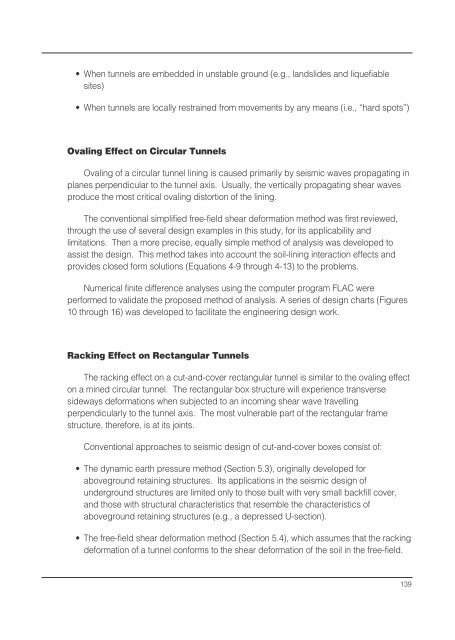Seismic Design of Tunnels - Parsons Brinckerhoff
Seismic Design of Tunnels - Parsons Brinckerhoff
Seismic Design of Tunnels - Parsons Brinckerhoff
Create successful ePaper yourself
Turn your PDF publications into a flip-book with our unique Google optimized e-Paper software.
• When tunnels are embedded in unstable ground (e.g., landslides and liquefiable<br />
sites)<br />
• When tunnels are locally restrained from movements by any means (i.e., “hard spots”)<br />
Ovaling Effect on Circular <strong>Tunnels</strong><br />
Ovaling <strong>of</strong> a circular tunnel lining is caused primarily by seismic waves propagating in<br />
planes perpendicular to the tunnel axis. Usually, the vertically propagating shear waves<br />
produce the most critical ovaling distortion <strong>of</strong> the lining.<br />
The conventional simplified free-field shear deformation method was first reviewed,<br />
through the use <strong>of</strong> several design examples in this study, for its applicability and<br />
limitations. Then a more precise, equally simple method <strong>of</strong> analysis was developed to<br />
assist the design. This method takes into account the soil-lining interaction effects and<br />
provides closed form solutions (Equations 4-9 through 4-13) to the problems.<br />
Numerical finite difference analyses using the computer program FLAC were<br />
performed to validate the proposed method <strong>of</strong> analysis. A series <strong>of</strong> design charts (Figures<br />
10 through 16) was developed to facilitate the engineering design work.<br />
Racking Effect on Rectangular <strong>Tunnels</strong><br />
The racking effect on a cut-and-cover rectangular tunnel is similar to the ovaling effect<br />
on a mined circular tunnel. The rectangular box structure will experience transverse<br />
sideways deformations when subjected to an incoming shear wave travelling<br />
perpendicularly to the tunnel axis. The most vulnerable part <strong>of</strong> the rectangular frame<br />
structure, therefore, is at its joints.<br />
Conventional approaches to seismic design <strong>of</strong> cut-and-cover boxes consist <strong>of</strong>:<br />
• The dynamic earth pressure method (Section 5.3), originally developed for<br />
aboveground retaining structures. Its applications in the seismic design <strong>of</strong><br />
underground structures are limited only to those built with very small backfill cover,<br />
and those with structural characteristics that resemble the characteristics <strong>of</strong><br />
aboveground retaining structures (e.g., a depressed U-section).<br />
• The free-field shear deformation method (Section 5.4), which assumes that the racking<br />
deformation <strong>of</strong> a tunnel conforms to the shear deformation <strong>of</strong> the soil in the free-field.<br />
139
















